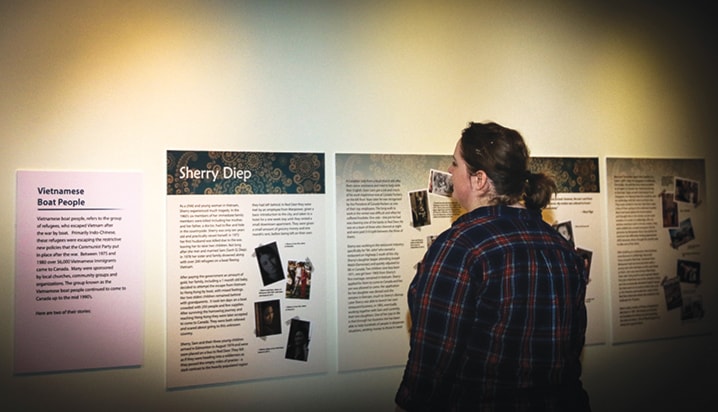Central Alberta Refugee Effort capped off its 35th year by preparing for more newcomers as Red Deer got ready to welcome Syrian refugees last week.
CARE evolved in response to the plight of Indo-Chinese refugees, known as ‘boat people,’ who left their homes in the late 1970s to escape the restrictive policies of the Communist regime after the Vietnam War.
The exhibit, CARE — Welcoming Immigrants to Central Alberta for 35 Years, at Red Deer Museum + Art Gallery, runs until Jan. 24 and follows the journey of two women who fled Vietnam and eventually called Red Deer home.
Muoi Ngo left Vietnam with her niece Tomy Huynh and survived seven harrowing encounters with pirates during her escape by boat in 1979. They spent nine months in a makeshift refugee camp in Indonesia before accepted as refugees in Canada.
At 10-years old, Sherry Diep practically raised herself in the 1960s after six members of her immediate family were killed. She escaped Vietnam by boat to Hong Kong with her husband and three youngest children before they were accepted by Canada.
Between 1975 and 1980, 56,000 Vietnamese people came to Canada. When the Red Deer Ministerial Association asked for assistance to help some of these refugees resettle in the region, CARE was born.
The group became a registered non-profit society and continues to help refugees and immigrants adjust to life in Canada.
Frank Bauer, CARE executive director, said CARE, in partnership with Catholic Social Services’ immigrant and settlement services, have about 1,500 active clients who regularly visit the immigrant centre for two or three years depending on how long they need English As A Second Language (ESL) classes.
He said between 700 and 1,000 newcomers arrive in Central Alberta every year.
Of those, about 70 are refugees, and the majority are economic immigrants.
“Apart from the refugees who are directly directed to our centre, no one else will get the information that there is an immigrant settlement agency in Red Deer so we have to rely a lot on word of mouth. That’s why we do a lot of public events, to make the community and newcomers aware that we exist,” Bauer said.
Some newcomers don’t need help. Others don’t realize they could use some assistance until they start sharing their questions and concerns, he said.
An important role of CARE is to help newcomers connect with others in their brand new country, he said.
“People never forget the first time someone recognizes them in the street or grocery store and says, ‘How are you doing and good to see you again.’”
One of the current goals of CARE is to link up with more community groups. Recently, CARE and Central Alberta Women’s Outreach formed a partnership so young, immigrant mothers can access child care and attend informal ESL classes at the outreach.
“It helps them to improve their English and gives them a reason to get out of the house, get out of their social isolation, and get to know about other social organizations.”
He said Canadians can by very friendly and welcoming, but newcomers are still faced with a new culture where they don’t always understand the differences.
“I always use the simple example of trying to order your first coffee at Tim Hortons. You get all those questions. What do you want? What size? Milk? Cream? Which way to go? It can be a challenge.”
He said learning or improving their English language skills is a priority for many newcomers. While CARE does offer translation services, people in the community could also make life a lot easier for newcomers by giving them more time to communicate and more attention during discussions so translation services aren’t always necessary.
Speaking with health care staff is particularly daunting for newcomers, he said.
“It’s fairly easy to explain to a doctor my knee hurts. But when the doctor starts asking more detailed questions, using more difficult terminology, they are very soon lost,” Bauer said.
People can view the CARE, along with another interactive exhibit featuring videos of more immigrants to the area telling their stories, at Red Deer Museum + Art Gallery from 10 a.m. to 4:30 p.m. on weekdays and noon to 4:30 p.m. on weekends. Admission is by donation.
szielinski@www.reddeeradvocate.com
